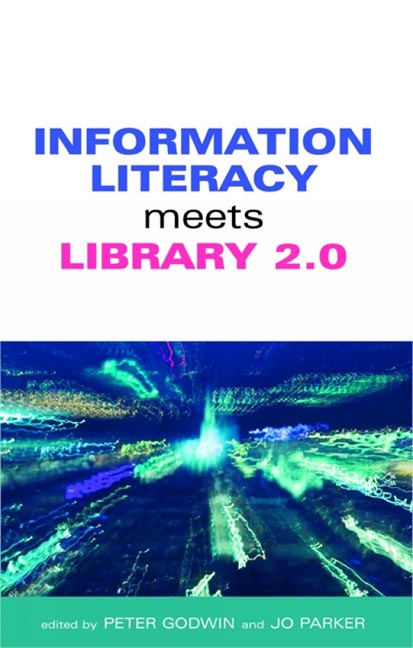Book contents
- Frontmatter
- Contents
- Contributors
- Acknowledgements
- Part 1 The basics 1
- Part 2 Library 2.0 and the implications for IL learning 37
- 3 Educating Web 2.0 LIS students for information literacy
- 4 School Library 2.0: new skills, new knowledge, new futures
- 5 Information literacy, Web 2.0 and public libraries: an exploration
- Part 3 Library 2.0 and IL in practice 75
- Part 4 The future
- Index
3 - Educating Web 2.0 LIS students for information literacy
from Part 2 - Library 2.0 and the implications for IL learning 37
Published online by Cambridge University Press: 08 June 2018
- Frontmatter
- Contents
- Contributors
- Acknowledgements
- Part 1 The basics 1
- Part 2 Library 2.0 and the implications for IL learning 37
- 3 Educating Web 2.0 LIS students for information literacy
- 4 School Library 2.0: new skills, new knowledge, new futures
- 5 Information literacy, Web 2.0 and public libraries: an exploration
- Part 3 Library 2.0 and IL in practice 75
- Part 4 The future
- Index
Summary
Introduction
Library and Information Science (LIS) students need to learn about Web 2.0 tools both in order to use them effectively themselves, and in order to use them in teaching information literacy to others. In this chapter I will discuss, first, whether LIS educators need to develop new frameworks and definitions of IL to reflect the rise of Web 2.0. I will then draw on work carried out for a European project on the LIS curriculum to identify the aspects of IL and Web 2.0 that LIS students need to address. The chapter concludes by identifying the different approaches that might be taken to enhance learning about IL using Web 2.0 tools.
What I will not do is discuss whether LIS educators need bother to incorporate Web 2.0 into the curriculum. Although specific Web 2.0 tools may come and go, it seems clear from the other chapters in this book that Web 2.0-type applications will only go away insofar as they develop into Web 3.0 applications.
IL: a new definition?
First, do we need a new definition for IL in a Web 2.0 world? Should LIS educators start by jettisoning the old definitions and trying to write new ones for their Web 2.0 or Web 3.0 students? In my view no, old definitions will do perfectly well. I will use the Chartered Institute of Library and Information Professionals’ (CILIP) definition as an example. This states that ‘Information literacy is knowing when and why you need information, where to find it, and how to evaluate, use and communicate it in an ethical manner’ (Armstrong et al., 2005).
A key issue is how you understand the concept of ‘information’. There is a substantial literature exploring and debating what information is (e.g. Capurro and Hjørland, 2003). The concept has been interpreted in many different ways, from the inclusive (communication) to the more restrictive (documents).
Commentators on IL may make the assumption that ‘information’ in IL definitions refers to textual information, but that is not necessarily the case. The notes on IL skills which accompany the CILIP definition make it clear that ‘information may be available on paper (books, reference works, journals, magazines, newspapers, etc), digitally (on CD-ROMs, over the internet or the world wide web, on DVDs, on your own computer or network, etc.), through other media such as broadcast or film, or from a colleague or friend’ (Armstrong et al., 2005).
- Type
- Chapter
- Information
- Information Literacy Meets Library 2.0 , pp. 39 - 50Publisher: FacetPrint publication year: 2008
- 1
- Cited by



